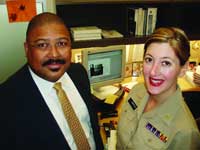FDA is right at home with VOIP

The Food and Drug Administration has begun consolidating headquarters staff on a new Maryland campus that will provide state-of-the-art facilities for administrators and scientists.

GOOD CALL: Deputy CIO Glenn Rogers, left, and Commander Melina Griffis already see the benefits of FDA's voice over IP system.
Case in point: a newly renovated FDA building for the Center for Drug Evaluation and Research. It brings together more than 1,700 employees who had been scattered in five buildings around Washington.
'I don't have to get into my car and drive to a meeting,' said deputy CIO Glenn Rogers. 'We have an awful lot of meetings. That's a big advantage.'
But VOIP presents even more advantages, from increased productivity to decreased telephone costs. So FDA designed the facility from the ground up to include a VOIP infrastructure. And the results are already being felt.
'I love the telephone system,' said Cmdr. Melina Griffis, a senior regulatory project manager for the Public Health Service working in the Center for Drugs. 'It's easy to use, and it's got lots of features. One of my favorite features is being able to pick up my voice mail from a computer.'
But the project required careful planning, which exploited fortuitous circumstances.
Starting with a blank slate presented advantages for the CIO's office, Rogers said. 'One of the greatest is that you have an opportunity to upgrade your infrastructure.'
FDA started with a wiring system that would provide flexibility. At the same time, the agency had its eye on providing voice communications over that wiring.
'We are using air-blown fiber,' Rogers said. 'Any time we need to change our wiring, we can suck it out without lifting a tile and blow in the new.'
Getting started
Rogers admits that when FDA started considering VOIP, it didn't have all the information needed for a successful deployment. The agency turned to companies such as Verizon Communications Inc., its prime telecommunications contractor, and Cisco Systems Inc. to help.
In 2000, the agency began a one-year pilot of 50 users to evaluate available products. Functionality and cost savings made the emerging technology a no-brainer. 'What started out as a hard decision became an easy decision,' Rogers said.
With VOIP, rather than having a telecom manager change phone numbers and locations, a worker can now pick up the phone when they move and plug it; the system will automatically recognize and register the phone.
FDA is using Cisco CallManager call-processing software and Unity Unified Messaging, which makes voice mail and e-mail accessible from the same queue, one of the most popular features of the system, Rogers said. Most of the phones are the Cisco 7960 model, a full-featured desk set, with other models used where appropriate.
The FDA system also will provide Enhanced 911 service, which can provide the exact caller location.
'We're putting in E911 servers that provide what we think is better service than you have today,' Rogers said. The system can pinpoint a caller down to the office they're in.
One of the keys has been starting small with a pilot and advancing gradually to a production environment. The first production phase included fewer than 200 employees in the Life Sciences Lab in 2004. Another 1,725 employees were added when the CDER building opened.
This phased approach helped to identify problems before they became major headaches.
'After we got to 2,000 users, we identified a design problem we were able to fix,' Rogers said. The system had been built with a flat network design. So, when an IP address problem cropped up, it took down the entire system. It took IT staff about four hours to redesign the network so any outages would remain isolated to about 20 at a time.
A stitch in time ...
With voice and data on the same network, availability was a major concern. Re-dundancy has been built into the infrastructure to ensure that phone service does not go down when network problems arise. Each wiring closet has its own uninterruptible power supply in case of local outages, and the campus has its own backup generator.
On the user side there have been few, if any, complications. FDA provides training on the phones before employees move to the new buildings.
'The training was helpful, but the phones are user friendly,' said Griffis, who uses about 80 percent of her phone's features. 'It's fairly intuitive.'
As with any other IT system, FDA's biggest VOIP-related help desk issue is password reset. That's mainly because workers can use a Web application to manage their phone features, Rogers said.
Only about one-quarter of FDA headquarters staff has moved to the new campus, but the infrastructure has plenty of room for growth, Rogers said. 'We're only using 5 percent of our bandwidth now.' That leaves plenty of capacity for when they turn up video-to-the-desktop for teleconferencing and training on demand.
'I just see it getting better, with all of the redundancy we built in,' Rogers said.





